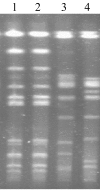Characterisation of community acquired non-typhoidal Salmonella from bacteraemia and diarrhoeal infections in children admitted to hospital in Nairobi, Kenya
- PMID: 17173674
- PMCID: PMC1764016
- DOI: 10.1186/1471-2180-6-101
Characterisation of community acquired non-typhoidal Salmonella from bacteraemia and diarrhoeal infections in children admitted to hospital in Nairobi, Kenya
Abstract
Background: In sub-Saharan Africa community-acquired non-typhoidal Salmonella (NTS) is a major cause of high morbidity and death among children under 5 years of age especially from resource poor settings. The emergence of multidrug resistance is a major challenge in treatment of life threatening invasive NTS infections in these settings.
Results: Overall 170 (51.2%) of children presented with bacteraemia alone, 28 (8.4%) with gastroenteritis and bacteraemia and 134 (40.4%) with gastroenteritis alone. NTS serotypes obtained from all the cases included S. Typhimurium (196; 59%), S. Enteritidis (94; 28.3%) and other serotypes in smaller numbers (42; 12.7%); distribution of these serotypes among cases with bacteremia or gastroenteritis was not significantly different. A significantly higher proportion of younger children (< 3 years of age) and those from the slums presented with invasive NTS compared to older children and those from upper socio-economic groups (p < 0.001). One hundred and forty-seven (44.3%) NTS were resistant to 3 or more antibiotics, and out of these 59% were resistant to ampicillin, chloramphenicol and tetracycline. There was no significant difference in antibiotic resistance between the two serotypes, S. Typhimurium and S. Enteritidis. Ceftriaxone and ciprofloxacin were the only antibiotics tested to which all the NTS were fully susceptible. Using Pulsed Field Gel Electrophoresis (PFGE) there were 3 main patterns of S. Typhimurium and 2 main patterns of S. Enteritidis among cases of bacteraemia and gastroenteritis.
Conclusion: Serotype distribution, antibiotic susceptibility and PFGE patterns of NTS causing bacteraemia and gastroenteritis did not differ significantly. The high prevalence of NTS strains resistant to most of the commonly used antimicrobials is of major public health concern.
Figures




References
-
- Blomberg B, Jureen R, Manji KP, Tamim BS, Mwakagile DS, Urassa WK, Fataki M, Msangi V, Tellevik MG, Maselle SY, Langeland N. High rate of fatal cases of pediatric septicemia caused by gram-negative bacteria with extended-spectrum beta-lactamases in Dar es Salaam, Tanzania. J Clin Microbiol. 2005;43:745–9. doi: 10.1128/JCM.43.2.745-749.2005. - DOI - PMC - PubMed
Publication types
MeSH terms
Substances
LinkOut - more resources
Full Text Sources
Other Literature Sources
Medical

